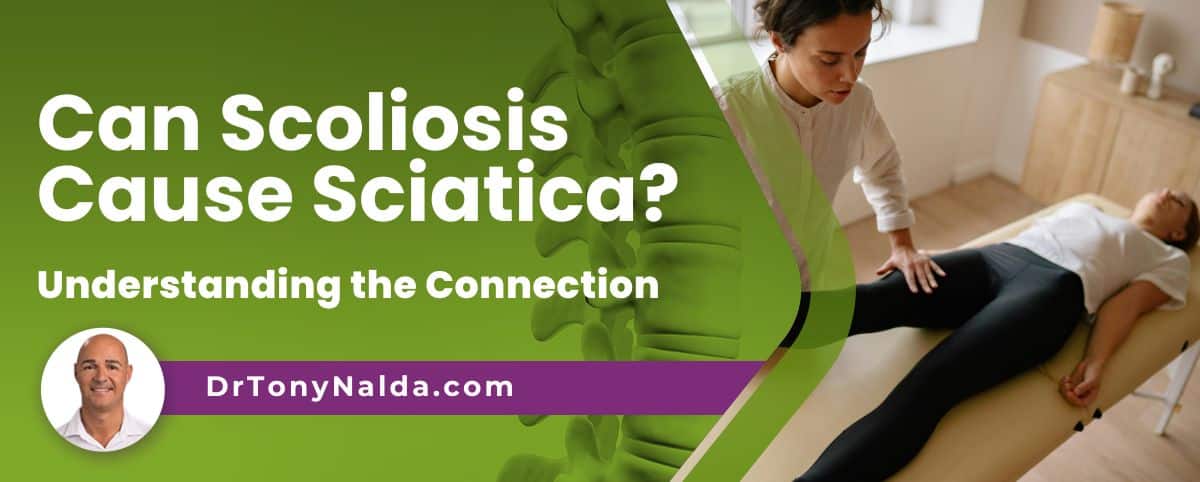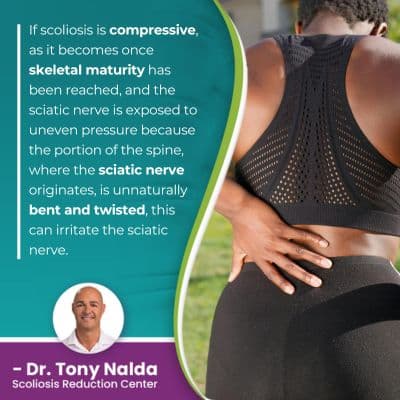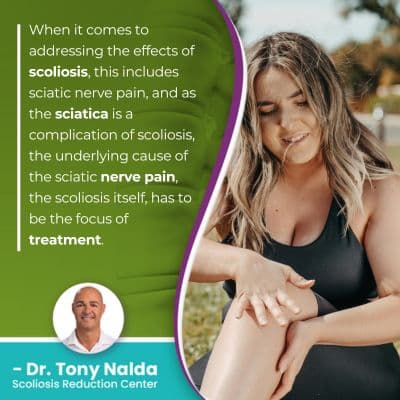Can Scoliosis Cause Sciatica? Understanding the Connection

Scoliosis causes the spine to bend and twist unnaturally, and this doesn't just affect the spine, but also its surrounding muscles and nerves. Nerve compression is more common in adults for whom the condition is compressive. Sciatic nerve compression mainly affects the left side of the lower body.
As the spinal cord and brain work together to form the body's central nervous system, spinal conditions can cause a myriad of effects felt throughout the body. When scoliosis develops in the lumbar spine, where the sciatic nerve originates, it can compress the nerve and cause sciatic nerve pain.
Scoliosis is associated with a number of effects and potential complications, one of which is sciatic nerve pain.
Table of Contents
The Sciatic Nerve
The sciatic nerve is the largest nerve in the body and is considered a mixed nerve because it contains both sensory and motor fibers.
The sciatic nerve starts in the lumbar spine and extends down the hip, buttock, leg, and into the foot; when the sciatic nerve is exposed to uneven pressure (compression), pain and/or discomfort can be felt anywhere along its extensive pathway.
In most cases, sciatic nerve pain is felt down the body's left side, but it can involve the right, and rarely, can affect both sides of the body.
The nature of sciatic nerve pain can vary with some experiencing mild and intermittent flare ups, during which time symptoms intensify and then abate, and others can face chronic and debilitating pain; severity depends largely on the degree of nerve involvement and the underlying cause.
What is Scoliosis?
Scoliosis is a highly-prevalent structural spinal condition that involves the development of an unnatural sideways-bending and rotating spinal curve, and as a progressive spinal condition, the nature of scoliosis is to get worse over time.
While we don't know what triggers most cases of scoliosis to develop, we do understand what makes it progress: growth and development.
Scoliosis progression means the size of the spine's unnatural curvature is going to increase, as are the condition's uneven forces, and their effects.
In children, the condition's main effects are postural changes caused by the condition disrupting the body's overall symmetry (uneven shoulders, shoulder blades, and uneven hips), and in adult patients, it's pain: back pain and pain that radiates into the extremities due to nerve compression.
Scoliosis doesn't become a compressive condition until skeletal maturity has been reached; during childhood, the spine is constantly growing, and that lengthening motion counteracts the compressive force of the unnatural spinal curvature, which is why scoliosis isn't known to cause noticeable back pain in children, but pain is the main reason adults come to see me for a diagnosis and treatment.
Now that we've explored the nature of the sciatic nerve, and defined scoliosis, let's discuss the connection between the two.
Scoliosis and Sciatica
 While most people think of sciatica as a condition, the actual term is more general and references pain and/or discomfort felt anywhere along the pathway of the sciatic nerve, so sciatic pain/sciatica is a symptom, not a clinical condition.
While most people think of sciatica as a condition, the actual term is more general and references pain and/or discomfort felt anywhere along the pathway of the sciatic nerve, so sciatic pain/sciatica is a symptom, not a clinical condition.
Scoliosis can develop anywhere along the spine, and when it develops in the lower back, this is diagnosed as lumbar scoliosis, and while sciatica is a common complication of lumbar scoliosis, it's not guaranteed.
No two cases of scoliosis are the same. The condition's effects are shaped by a number of variables: patient age, condition type, severity, and curvature location.
In most spinal conditions, the area of the body located closest to the affected spinal section is going to feel the majority of the condition's direct effects.
If scoliosis is compressive, as it becomes once skeletal maturity has been reached, and the sciatic nerve is exposed to uneven pressure because the portion of the spine, where the sciatic nerve originates, is unnaturally bent and twisted, this can irritate the sciatic nerve.
If the sciatic nerve is compressed, it can become irritated, inflamed, pinched, and/or impinged.
Symptoms of Sciatic Nerve Compression
Scoliosis introduces a lot of uneven forces to the spine, its surrounding muscles and nerves, and the entire body, and as scoliosis gets worse, its effects also become more severe, including nerves compression.
So for those experiencing sciatic nerve pain, what does it feel like?
Sciatic nerve compression can cause:
- Burning sensations
- Numbness and/or tingling sensations
- Electric shock-like sensations
- Lower back pain
- Hip pain
- Leg pain
- Foot pain
- A reduced range of motion in the lower body
- Bladder issues (more common in severe cases)
So now that we know the connection between scoliosis and sciatica, let's talk about how best to alleviate scoliosis-related sciatic nerve pain.
Scoliosis Treatment and Pain Relief
When it comes to addressing the effects of scoliosis, this includes sciatic nerve pain, and as the sciatica is a complication of scoliosis, the underlying cause of the sciatic nerve pain, the scoliosis itself, has to be the focus of treatment.
To treat lumbar scoliosis, here at the Scoliosis Reduction Center, patients suffering from sciatic nerve pain will benefit from a proactive conservative treatment plan that is fully customized to address key patient/condition variables, including experienced symptoms.
Conservative treatment is integrative and proactive; it starts treatment as close to the time of diagnosis as possible because as a progressive condition, the best time to start treatment is always now.
 Scoliosis only gets more complex to treat, and when it comes to condition effects, it's generally far more effective to proactively work towards preventing progression and increasing effects than it is to attempt to reverse condition effects once they're established.
Scoliosis only gets more complex to treat, and when it comes to condition effects, it's generally far more effective to proactively work towards preventing progression and increasing effects than it is to attempt to reverse condition effects once they're established.
Conservative treatment is condition-specific and can include chiropractic care, physical therapy and scoliosis-specific exercises, corrective bracing, and rehabilitation.
Chiropractic adjustments and a variety of techniques are applied with the goal of working towards a curvature reduction; as a structural spinal condition, scoliosis has to, first and foremost, be impacted on a structural level.
Chiropractic adjustments can help reposition the curve's most-tilted vertebrae at its apex back into alignment with the rest of the spine; when the spine is aligned, this means its vertebrae are stacked on top of one another in a straight and neutral alignment.
A spine that's aligned means the spinal nerves within, or where they exit the spine, aren't being exposed to uneven pressure, so nerves are left with the space needed to function optimally within.
Once I start to see structural results, I focus on increasing core muscle strength so the spine is optimally supported and stabilized, and this also relieves pressure on the spine and its individual structures and nerves.
Corrective bracing is more useful when treating childhood scoliosis as the spine is still growing, but in adults, corrective bracing can also help increase spinal stabilization and provide short-term pain relief.
Rehabilitation involves a series of custom-prescribed home exercises so patients can continue to heal and stabilize their spines from home for long-term sustainable treatment results.
So while developing sciatic nerve pain is a common complication of lumbar scoliosis, it's not a common effect when scoliosis develops in the thoracic or cervical spinal sections, based on the nerve's location.
Conclusion
So can scoliosis cause sciatica: yes, it can, but is most closely associated with scoliosis that develops in the lower back and isn't a guaranteed condition effect.
As the sciatic nerve starts in the lumbar spine, if that section of the spine develops an unnatural spinal curve, it's not just the lumbar spine that's exposed to uneven pressure, but also its surroundings, including nearby nerves.
If a nerve is compressed, related symptoms will depend on the nerve in question and its location; sciatic nerve damage can cause a burning sensation, radiating pain, inflammation affecting the nerve's surroundings, and as a mixed nerve, a pinched sciatic nerve can also affect the function and movement of the lower body.
Sciatica pain can vary in severity, and when it comes to understanding the relationship between scoliosis and sciatica pain, the connection is how compression can cause pinched nerves, and if scoliosis is compressive and causes the sciatic nerve to become pinched, this means it doesn't have the space it needs to function optimally within, disrupting its neurological function.
A scoliotic spine is virtually guaranteed to get worse over time, which means symptoms increase, and common treatments have to address the underlying structural nature of scoliosis by working towards a curvature reduction.
While treatment results can never be guaranteed, treating scoliosis proactively is associated with a positive response, and conservative treatments have the goal of correcting the spine's abnormal curvature and increasing core strength so the spine is supported and stabilized by strong core muscles.
Dr. Tony Nalda
DOCTOR OF CHIROPRACTIC
After receiving an undergraduate degree in psychology and his Doctorate of Chiropractic from Life University, Dr. Nalda settled in Celebration, Florida and proceeded to build one of Central Florida’s most successful chiropractic clinics.
His experience with patients suffering from scoliosis, and the confusion and frustration they faced, led him to seek a specialty in scoliosis care. In 2006 he completed his Intensive Care Certification from CLEAR Institute, a leading scoliosis educational and certification center.
About Dr. Tony Nalda
 Ready to explore scoliosis treatment? Contact Us Now
Ready to explore scoliosis treatment? Contact Us Now





